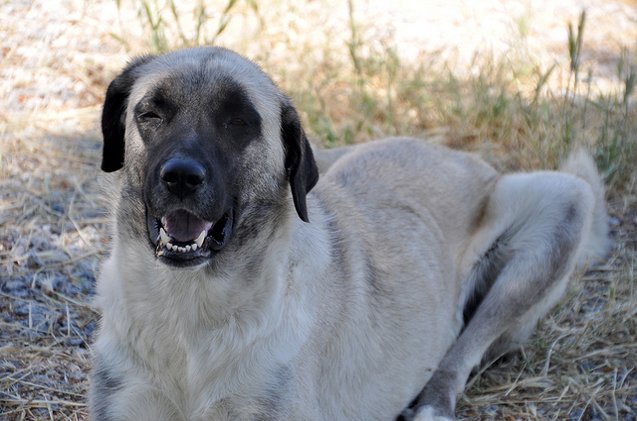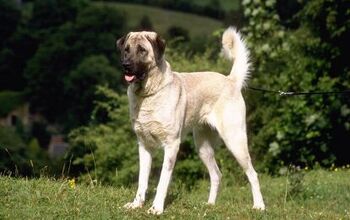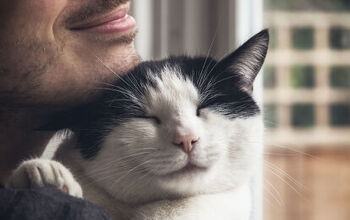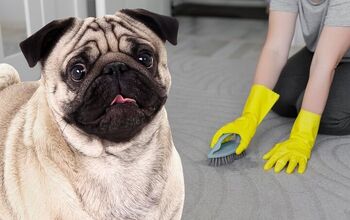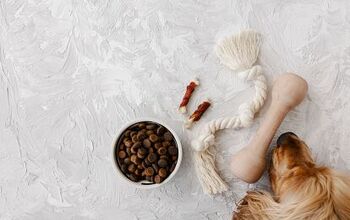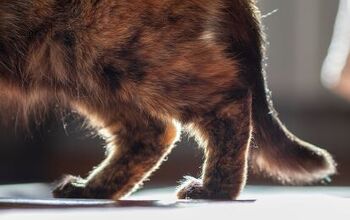Kangal Dog


About Kangal Dog
Kangal Dog Basics
The Kangal Dog is a large and powerful breed, often used in Turkey to guard livestock against predators. This dog is easily recognized by its massive head, dark muzzle, and curled tail which is carried up and over the back. When viewed from the side, the Kangal has a distinctive silhouette. It’s no challenge to pick this dog out from a lineup, there aren’t any pups out there quite like it.
But don’t let the Kangal Dog’s imposing physique intimidate you. Appearances can be deceiving and this majestic breed is the true definition of a gentle giant. While they are alert and make ideal watchdogs or guard dogs, there’s not an ounce of aggressiveness or viciousness in the Kangal Dog. These fierce guardians have a peaceful nature and serene demeanor. When push comes to shove, they would rather block the intruder than actually attack them, like some other guard dog breeds. This isn’t a dog for anyone simply seeking protection. Nope, despite what you might think at first glance, the Kangal dog is more about love and protection than fear and intimidation.
It goes without saying that you should only get a Kangal Dog if you have a space for one. These dogs need a lot of space, and a house with a big, securely fenced yard is the ideal setting for them. Owners need to be experienced dog owners who understand clearly the proper ways to manage and correct bad behavior in a Kangal. If this dog is subject to negative corrections (spanking or other poor training methods), a typical Kangal will not tolerate being treated this way, leading to a total failure for the dog and family as well.
So, is The Kangal Dog the big burly boy that you need to bring home to your family? You’ve come to the right place to find out. Keep your eyes glued to this page and scroll away. We are about to reveal everything that there is to know about this beautiful breed. By the end, you’ll know whether or not you need one of these big boys in your life.
The Kangal Dog is a large and powerful breed, often used in Turkey to guard livestock against predators.
Origin
Though there is some debate regarding the details of this breed’s origins, the Kangal Dog is known to come from Turkey where it was used as an ancient flock-guarding breed. The Kangal is thought to have descended from various mastiff-type dogs such as those depicted in ancient Assyrian art. This breed gets its name from the Kangal District of Sivas Province in Turkey and this location is also likely where it originated. Throughout its history, the Kangal has been associated with the Aga of Kangal, a large family of landholders and chieftains that use the dogs to guard flocks against large predators such as bears, jackals and wolves. This breed’s history as protectors is legendary.
The first mention of the Kangal Dog in European literature during the late 1900s. In 1985, David and Judith Nelson brought their Kangal to the United States where it, along with other imports, served as the foundation stock for the Kangal Dog in the U.S. There continues to be some debate regarding whether the Kangal Dog is actually a separate breed from the Anatolian Shepherd, another Turkish breed. It is commonly accepted, however, that true Kangal Dogs are a separate breed from generic Turkish shepherd dogs. So, at least that statement carries no controversy.
Pedigree
Owing to the ongoing debate among canine experts if, in fact, there are enough differences between the Anatolian Shepherd Dog and the Kangal Dog for them to be separate breeds, there is some confusion about these dogs in the United States. The American Kennel Club recognizes Anatolian Shepherd, noting that this breed is “also known as the Kangal”. Their view of these remarkable dogs is they boast many qualities, most prominent being that they’re “smart, devoted, responsive, and adaptable”.
Regardless of any pedigree certification, though, you can be certain that your Kangal puppy has admirable roots. The breed has quite a history, with some sources placing its origin as far back as 12th century (Something that perhaps the AKC should look into before making their rash decisions about the Kangal Dog).
Food/Diet
Given the fact that the Kangal is a very large breed of dog, it is important that you provide a diet formulated for large-breed dogs. Kangal Dogs have an efficient metabolism, so max for working males is 5-1/2 to 6 cups quality kibble per day; females eat 3-1/2 to 5 cups. Also, maximum protein is 23%, otherwise they develop health issues. In Turkey, this breed was fed a high-grain/starch diet and scavenged for their protein on carcasses and wild rodents and small prairie birds. The Kangal Dogs in North America are only a couple generations from their home land - not enough to have changed the 1,000s of years of genetics. Puppies move to adult dog food at 5-6 months old. They must grow slowly to prevent crippling leg pain from bone plate issues.
Naturally, while protein should make up for the better part of the formula, the Kangal will also need essential fatty acids, often introduced through flaxseed or fish oil in the kibble, plenty of glucosamine and chondroitin (interestingly, it often comes through bone meal) to support their joint health, fiber and carbs to give them energy and promote good digestion, as well as all the vitamins and minerals they need to support their overall health.
Alternatively, some Kangal Dog owners opt for cooking balanced meals tailored for their unique needs or preparing (or buying) raw dog food as well. While both of these can be a good choice for your dog, they shouldn’t be your primary choice unless you’ve talked to a professional and established what your dog’s exact dietary needs are – otherwise, you risk nutritional deficiencies and endangering your pet’s health. Canine nutrition might seem simple at first but it does require a lot of knowledge and research to be truly able to provide a wholesome, healthy diet to your pet.
As always, if you are in any way concerned about altering or establishing your Kangal Dog’s diet, then it’s wise to consult with a veterinarian before making any major decisions. While most dog food manufacturers and pet blogs provide useful feeding guidelines, they should still be treated as guidelines and not gospel. All dogs are different after all and only your vet is qualified to determine the specific dietary needs of your personal pooch. So, always rely on the expertise of your vet before making any major decisions regarding your pooch’s diet.
The Kangal Dog is smart and can be trained to guard livestock as well as property.
Training
The imposing and majestic Kangal dog would be a very difficult creature to deal with if they weren’t easily trainable – just imagine a rowdy 130 lbs dog that ignores your commands. Yikes!
Kangal Dogs start out as independent thinkers, even stubborn, and need very little training to become fantastic livestock guardians. But it is extremely challenging to train them to do anything else. Even when “trained”, these dogs will always be independent thinkers and will always make their own decisions. They do not ever reliably recall, and can never be trusted outside their fence off-leash. They will travel miles and willingly miss dinner to explore territory.
This breed is loyal to their territory and livestock more than to their people. They do not like leaving their territory (which is different than exploring and expanding territory); if you take them for a jog, they assume you are doing a perimeter check and giving them ownership of that territory. They will expect to pause and pee-mark every shrub, post and object.
Kangal Dogs, and all livestock guardians in general, tend to be nocturnal and prefer to sleep outside. They bark in the night. An owner can expect their Kangal Dog to bark in the night every night of his/her life, even in the house (actually, even more in the house because they are frustrated at not checking on what they hear). This equates to interrupted sleep every night.
However, because these dogs can become independent and stubborn, it is important to start training from a young age. This would mean that you need to housebreak your pet too. It might take some effort, but positive reinforcement methods yield great results (always focus on rewards and encouragement in your training as anything less is closer to abuse than training).
Of course, since the Kangal Dog is a working breed, don’t neglect their need to have a task to do – they need something to occupy them, otherwise they can become bored and destructive. Fail to give your Kangal something to do and something to watch or shepherd, and you’ll see chewed up shoes, digging holes in the garden, and other unwelcome sights.
Kangal Dogs are not food-motivated, so they cannot be trained using treats. They will walk away even from their food dish if it is held hostage for some trick, other than a respectful sit.
Weight
The average weight for a male Kangal Dog is between 110 and 145 pounds while females weigh between 90 and 120 pounds. In other words, he’s a big boy! These dogs can often feel like they are closer to roommates than pets. Across the world, Kangal Dogs are known for being burly, tall, and powerfully built dogs, giving them that iconic look of gentle giants. Needless to say, all big dogs require plenty of balanced food to fuel their energy levels and muscles. Be ready to invest in quality dog food. And it shouldn’t come as a surprise if your Kangal needs a bit more food on a monthly basis than some other breed of medium size. Luckily, Kangals are difficult to become obese, especially if they are given a chance to exercise and walk.
Temperament/Behavior
Despite its size, the Kangal Dog is a controlled breed. When their owners work with them on time, they grow up to be docile and even tempered dogs. However, these dogs do tend to develop an independent streak if proper training and socialization is not achieved from a young age. So, it’s important for anyone who owns these remarkable animals to treat their training and socialization relationship very seriously.
Kangal Dogs are generally friendly with visitors and often get along well with children. These dogs should never be shy or vicious, but they do tend to be protective of their families. This breed was bred to guard livestock, so you shouldn’t be surprised if you find your dog standing watch over your children or other pets. Because these dogs can be a handful at times, they are generally not recommended for inexperienced dog owners. It takes an experienced dog owner who takes their responsibilities seriously to raise these big and beautiful dogs right.
Kangal Dogs are both apex guardians and expect to be alpha in any dog-dog encounter. They feel justified in discipling disrespectful behavior on the part of another dog. On a leash these dogs are very polite; they rarely initiate aggression towards another dog. But they also do not expect another dog to trespass within their space without permission. Don't take your Kangal Dog to to an off-leash park, because there are many other badly behaved dogs out there.
More than anything, Kangal Dogs love belly rubs and chest scratches.
Common Health Problems
The Kangal Dog is typically a healthy breed and, as long as they have been bred responsibly, they do not have many congenital conditions. Like all dogs, however, the Kangal Dog breed is prone to certain minor conditions including benign tumors, entropion and hip dysplasia. That’s as far as genetic predispositions go, of course, but there’s always the possibility of various acquired diseases if you neglect your pet’s health and needs. Large dogs such as the Kangal tend to have issues with bone system as they age, whether it’s chronic joint pain or impaired mobility in their golden years, so it’s a good idea to introduce joint supplements on time.
As always, it’s important to maintain regular checkups (especially as your dog enters their senior years) so that any potential health issues are identified and treated as early as possible. Noticing symptoms on time and catching certain conditions early can make a world of difference, both when it comes to treatment success and your pet’s quality of life!
Life Expectancy
The average lifespan for the Kangal Dog is between 12 and 15 years, which is quite impressive for a dog of this size. It is not uncommon for Kangals to reach 15 years of age, which is amongst the highest in the dog world – so, not only are they hardy, but make great companions as well. If you were looking for a doggo to share your life with, a Kangal could be the ideal choice. They also tend to bond fiercely with their owner, so you’ll be looking at a strong friendship for many years.
Exercise Requirements
The Kangal Dog is a large dog and needs plenty of time to stretch its legs and work off its energy during the day. To boot, this breed was originally created to be a working dog, and they will need to occupy themselves with something to be content (ideally they can occupy themselves with watching over their family). So, if you want to get a Kangal Dog, be prepared to provide both mental and physical stimulation they crave. Working dogs of this breed usually get all their needs met through their jobs, but companions and pets will need to be deliberately exercised. While these dogs are not overly active, they will require outdoor space to roam about and guard. They’ll also benefit from circa 60 minutes of daily walks or playtime with the owner.
Despite its size, the Kangal Dog is a fairly calm and controlled breed.
AKC
The Kangal Dog is not currently recognized by the AKC and it was only recognized by the UK Kennel Club in 2012 as part of the Pastoral Group. In the U.S., the Kangal Dog is recognized by the United Kennel Club. In Australia in 2012, the Australian National Kennel Club stopped recognizing the Kangal as a separate breed from the Anatolian Shepherd Dog. Hopefully one day the AKC will follow suit. In America, the “Kangal Dog Club of America”, better known as KDCA, is the national parent club for this breed, and the only such organization in the United States. The club is committed to maintaining an open registry for this breed, as well as providing all the necessary information regarding the pedigree and the standards of the Kangal.
Coat
The Kangal Dog has a short, dense coat that does not require a great deal of grooming. The coat is generally fawn or tan in color with a black facial mask and black shading on the ears. Some white markings may be allowed on the chest, chin or toes but the coat should not be spotted, brindled or broken. Remember that Kangal dogs will likely shed heavily twice per year, for a short period of time. This is a natural occurrence and a time when they shed their undercoat. During this time, you will be required to do some heavy brushing and grooming in order to get rid of all that excess hair. Still, the job is not too demanding, and the rest of the year you’ll have your hands free, since Kangal dogs don’t shed all that much throughout the year.
Puppies
It is very important to start socialization and training right away with Kangal Dog puppies. These dogs require firm leadership and consistent training along with adequate socialization. Kangal Dog puppies tend to grow very quickly and they often develop a tendency to chew, so keep an eye on them. It’s important to take your puppy parenting responsibilities seriously so that your Kangal Dog can grow into his best self. Granted, Kangal dogs have a set of inherent abilities and tendencies very early on. They tend to watch and learn from the habits of older, seasoned dogs. In their natural setting – guarding flocks – this is a great advantage. But around the house, they’d do better learning from you rather than another dog. Luckily, this also means that Kangal puppies will be quick to learn and rather smart. All they need is a nudge in the right direction and some early socialization!
Photo credit: Jarekt/Wikimedia; Kate Kranzler (Izgi)/Flickr; Sarah Murray/Flickr

Amy Tokic, Editor of PetGuide.com, is a passionate animal lover and proud pet parent of Oscar, a Shih Tzu/Chihuahua cross, and Zed, a Japanese Chin. Her love of animals began in kindergarten, when she brought her stuffed dog Snoopy into class with her every day. Now, she writes about her adventures in pet ownership and tirelessly researches products, news and health related issues she can share with other animal enthusiasts. In her free time, Amy loves perusing used book and record stores, obsessing over the latest pet products available and chasing squirrels with wild abandon (a habit attributed to spending too much time with her pooches).
More by Amy Tokic



